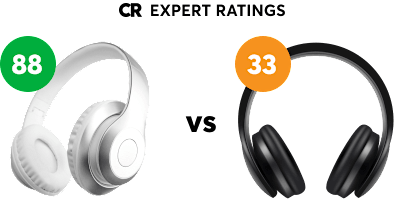Design and features:The headphones work with or without the noise canceling feature being turned on, and you can use the noise-canceling feature without listening to music. These headphones can be used wirelessly with Bluetooth devices or can be cord connected. When cord connected they have medium-high sensitivity regardless of whether the noise canceling feature is turned on or off, so they can provide satisfying volume levels when used with home audio equipment and even lower-powered portable audio devices. They can also be connected to a computer via a USB cable to play audio files stored on the computer. The PX has a noise canceling on/off button, a built-in microphone and integrated volume and music player function Bluetooth and USB computer controls, and a call connect/disconnect Bluetooth control. Additional features include automatic turn on and off when the headphones are placed on or removed from the head respectively and earcups that swivel to flat for ease of storage and transport. The free Bowers & Wilkins Headphone app download for Apple and Android mobile devices adds more features such as additional levels of noise reduction, adjustable voice ambient sound monitoring, and firmware updating. This model comes with a detachable 48-inch long standard audio cable, a USB charging/data cable, and a carrying pouch.
Sound quality: We found the PX provides Excellent active noise reduction and that the sound quality was pretty much the same when the noise cancelling feature was turned on in the Bluetooth or the wire connected mode. When the noise cancelling feature is turned on it delivers sound quality that falls in the Very Good range - it reproduces music and voice very well although it does have some noticeable sonic quirks. The overall sound can best be summarized as somewhat claustrophobic and plasticy. The bass (as in bass drums, bass guitars, stand-up bass, etc.) has good impact and goes fairly deep, but is a bit prominent and boomy. The midrange (voices, guitars, horns, etc.) is fairly even, but is somewhat constricted (as in straightjacketed) and has a noticeable plastic resonance (something like what you would hear if you talked into a semi-rigid plastic cup). The treble (cymbals, the upper range of violins, etc.) is fairly extended, but the lower treble is subdued. While the sound has a decent sense of liveliness and the headphones do a good job of recovering the room ambience of a recording (the sense of the acoustic space in which the audio program that's being listened to was recorded), they sound somewhat closed-in (sound-wise it is somewhat obvious that you have something covering your ears). When the noise cancelling feature is turned off in the Bluetooth or cord connected mode the sound quality, while still in the Very Good range, is slightly improved from when the noise canceling feature is engaged. Compared to when the noise canceling mode is engaged the midrange looses the constricted quality and the plasticy sound is less noticeable, the treble becomes more even, and the overall sound becomes more open. If the earpad seals are broken (which can be caused by chewing while wearing the headphones) the sound becomes noticeably more plasticy. These headphones provide Excellent noise reduction across the entire frequency range with the low frequencies reduced the most, but for the best results you do have to make sure the earpads are providing a good seal all around the ears. When the noise canceling feature is turned on there is a very faint hiss that can be heard in quiet environments when there is no audio program material to mask it; regardless of whether the noise canceling feature is turned on or not, if these headphones are cord connected to AC powered audio equipment there may be noticeable background hiss and hum.
Comfort: We found that these headphones produce a sense of moderate pressure around the ears. As typical of on-ear models the pads might feel hot and/or sticky after prolonged use. Users with larger ears might find that the over-the-ear fit of the ear pads feel cramped, or that the ear pads sit on, rather than around their ears; in that case the less-than-ideal fit around the ears might interfere with the earpad seal and reduce the noise reduction capabilities and/or change the sound quality of the headphones. Some users might find that the headphones feel unstable and shift forward a bit and may even fall off when they lean far forward. When wearing this model while walking the vibrations from each foot step can be heard faintly through the headphones, and when the audio cable is connected the sound of it rubbing on clothing may also be heard faintly through the headphones.

























